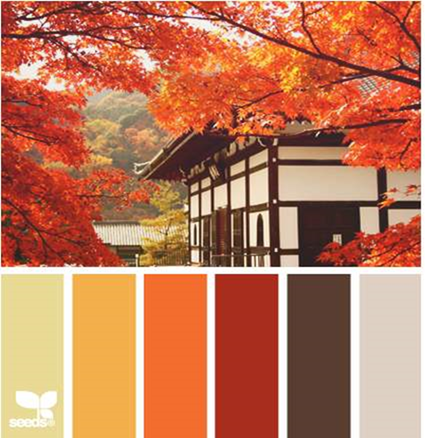What is the Traditional Thanksgiving Color Palette? 10 Reasons Behind This
Thanksgiving is a beloved holiday that unites families and communities, offering a time for reflection, gratitude, and feasting. It is also a time for tradition and celebration, where the sights and sounds of the season create a rich, festive atmosphere. One of the most recognizable elements of Thanksgiving is its color palette—a stunning mix of warm, earthy tones that evoke the spirit of fall. But what exactly is the traditional Thanksgiving color palette, and why are these colors so prominent during the holiday? In this article, we will explore the meaning and significance of these colors and offer ten reasons why they are the perfect representation of Thanksgiving.
The Traditional Thanksgiving Color Palette
The traditional Thanksgiving color palette consists of a blend of warm, rich, and earthy tones that reflect the harvest season and the natural beauty of autumn. Some of the most common colors associated with Thanksgiving include:
- Burnt Orange: Often seen in pumpkins, fall foliage, and autumn décor, this rich hue symbolizes warmth, abundance, and the changing season.
- Deep Red: A color seen in cranberries, apples, and leaves, deep red is a color of vitality and harvest.
- Golden Yellow: Reminiscent of autumn leaves, corn, and the harvest season, golden yellow symbolizes prosperity and the bounty of the earth.
- Brown: A grounding color that represents the earth itself, brown is a color of stability and tradition, often associated with the harvest.
- Dark Green: Found in pine trees and other autumn foliage, dark green evokes feelings of growth and renewal.
- Cream or ivory: Often used in table settings, this soft and neutral color adds balance and warmth to the traditional Thanksgiving palette.
These colors together create a harmonious visual representation of the fall season, filled with warmth, abundance, and the connection to nature and the earth. But why are these colors specifically chosen for Thanksgiving? Let’s explore ten reasons that go beyond their aesthetic appeal.
1. Reflecting the Harvest Season
The colors associated with Thanksgiving are directly tied to the harvest season, which is the central theme of the holiday. Thanksgiving is a time to celebrate the fruits of the earth—fruits and vegetables like pumpkins, squash, cranberries, apples, and sweet Potatoes dominate the dinner table. These foods are rich in earthy tones like orange, red, yellow, and brown. The color palette mirrors this abundance, emphasizing the deep connection between nature and the holiday.For instance, orange is the color of pumpkins, a quintessential symbol of fall and Thanksgiving. The color red reflects the ripeness of cranberries and apples, while yellow mirrors the corn and grains harvested at this time of year.
2. Evoking Warmth and Comfort
Thanksgiving is a time for family gatherings, where warmth and togetherness are key. The color palette of the holiday emphasizes warmth through its rich, earthy tones. Burnt orange, deep red, and golden yellow evoke feelings of coziness and comfort. These colors are not only visually appealing but also create an atmosphere that encourages closeness and relaxation, making them perfect for family dinners and festive gatherings.
The color brown, which is often seen in rustic décor and autumn foliage, also contributes to this sense of warmth.
3. Symbolizing Gratitude and Prosperity
At its heart, Thanksgiving is a holiday centered around giving thanks for the blessings and abundance of the year. The colors of the Thanksgiving palette symbolize prosperity and gratitude—core themes of the holiday. The color golden yellow is often associated with wealth and abundance, reminding us of the bounty of the harvest. Similarly, deep red represents vitality, growth, and the fruits of the earth, while orange reflects the harvest season’s generosity.These colors collectively communicate the idea of gratitude for what has been received—whether it’s food, family, or simply the richness of life itself.
4. Celebrating Autumn and Nature’s Beauty
Thanksgiving falls at the peak of autumn, when the landscape is ablaze with rich colors. The trees are adorned in shades of red, orange, yellow, and brown, creating a breathtaking natural spectacle. Colors like deep red, burnt orange, and yellow are directly inspired by the changing leaves, which are often the first signs of the season’s shift. These hues capture the essence of autumn and remind us to appreciate the natural world around us. Thanksgiving, therefore, becomes not just a celebration of the harvest but also of the stunning transformation happening in nature.
5. Representing Family and Tradition
The colors of Thanksgiving are also deeply connected to family and tradition. Brown and cream are classic, timeless colors that evoke a sense of stability and continuity—qualities that are essential to family gatherings. Furthermore, the earthy tones of the Thanksgiving palette have a rustic quality that connects the holiday to its historical roots. Many Thanksgiving traditions stem from the early days of the Pilgrims and Native Americans, who celebrated the harvest with simple, humble feasts. The colors of fall reflect this connection to tradition, making them perfect for a holiday that honors the past while celebrating the present.
6. Encouraging Reflection and Togetherness
The colors of Thanksgiving also encourage reflection and togetherness. The warm tones of orange, red, and yellow create an inviting space that encourages people to slow down and appreciate the moment. These colors promote a sense of calm, making them ideal for a holiday centered around sharing a meal with loved ones and expressing gratitude.The subtlety of neutral tones like cream and brown provides balance to the more vibrant colors, creating a harmonious environment conducive to reflection. The color palette supports an atmosphere where people can come together, share memories, and give thanks for the blessings they’ve received throughout the year.
7. Signifying the Connection to the Earth
Thanksgiving is rooted in the tradition of celebrating the earth’s bounty. The color palette of the holiday, with its rich earth tones like brown and green, signifies a deep connection to the natural world. Brown evokes the color of the soil and represents the life and growth that spring and summer bring. This connection to the earth underscores Thanksgiving’s focus on the harvest and the role of the earth in providing sustenance. The colors serve as a reminder of the importance of nature and the cycles of life that allow us to enjoy food, family, and community during the holiday.
8. Setting the Tone for Festive Meals
Thanksgiving is a food-centered holiday, and the colors of the holiday are closely tied to the meals shared with loved ones. mashed potatoes, cranberry sauce, and pumpkin pie. These hues create an inviting atmosphere for the festive meal, enhancing the sensory experience of dining.In addition, the neutral tones of cream and brown are often incorporated into table settings and décor, helping to create a sophisticated yet cozy ambiance for the meal. The colors reinforce the importance of the feast and the joy of coming together over shared food.
9. Creating a Cozy, Welcoming Atmosphere
As the weather grows colder in late November, the colors of Thanksgiving help create a cozy and welcoming atmosphere. The deep, warm hues of orange, red, and yellow evoke the feeling of a crackling fire, soft blankets, and a home filled with love. These colors make people feel comfortable and embraced, encouraging them to relax and enjoy the holiday.Additionally, the use of cream and brown tones helps tone down the vibrancy, ensuring the space feels inviting without being overwhelming. Together, these colors create an environment that is perfect for family gatherings and intimate celebrations.
10. Highlighting the Spirit of Grace
At its core, Thanksgiving is a celebration of gratitude. The colors associated with the holiday visually express this sentiment. Red, orange, yellow, and brown represent the blessings of the harvest, while the more neutral tones of cream and brown offer a grounded, humble backdrop for expressions of thankfulness.The overall effect of the Thanksgiving color palette is one of appreciation—for family, nature, food, and the connections that bind us together. These colors remind us to pause, reflect, and give thanks for the good in our lives.
Conclusion
The traditional Thanksgiving color palette is a rich blend of warm, earthy tones that reflect the beauty of autumn, the abundance of the harvest, and the spirit of gratitude that defines the holiday. From the vibrant hues of burnt orange and deep red to the calming neutrals of cream and brown, each color serves to create a welcoming, cozy atmosphere perfect for family gatherings and festive meals. The palette not only represents the natural world but also encapsulates the themes of Thanksgiving, tradition, and togetherness. These colors remind us to appreciate the simple blessings of life and celebrate the bonds that bring us together.
Share this content:



